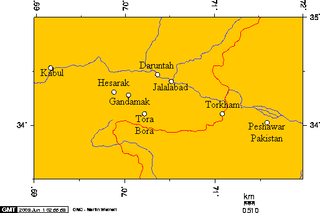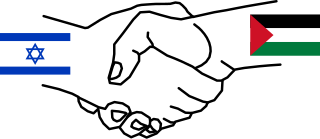Borders are geographic boundaries, imposed either by geographic features such as oceans, or by arbitrary groupings of political entities such as governments, sovereign states, federated states, and other subnational entities. Borders are established through warfare, colonization, or simple symbiotic agreements between the political entities that reside in those areas; the creation of these agreements is called boundary delimitation.

A border checkpoint is a place, generally between two countries, where travelers or goods are inspected. Authorization often is required to enter a country through its borders. Access-controlled borders often have a limited number of checkpoints where they can be crossed without legal sanctions. Arrangements or treaties may be formed to allow or mandate less restrained crossings. Land border checkpoints can be contrasted with the customs and immigration facilities at seaports, international airports, and other ports of entry.

In general, a port of entry (POE) is a place where one may lawfully enter a country. It typically has border security staff and facilities to check passports and visas, and inspect luggage to assure that contraband is not imported. International airports are usually ports of entry, as are road and rail crossings on a land border. Seaports can be used as ports of entry only if a dedicated customs presence is posted there. The choice of whether to become a port of entry is up to the civil authority controlling the port.

The Canada–United States border is the longest international border in the world between two countries. The terrestrial boundary is 8,891 kilometers (5,525 mi) long. The land border has two sections: Canada's border with the U.S. to its south, and with the U.S. state of Alaska to its west. The bi-national International Boundary Commission deals with matters relating to marking and maintaining the boundary, and the International Joint Commission deals with issues concerning boundary waters. The agencies currently responsible for facilitating legal passage through the international boundary are the Canada Border Services Agency (CBSA) and U.S. Customs and Border Protection (CBP).

The Republic of Ireland–United Kingdom border, sometimes referred to as the Irish border or British-Irish border, runs for 499 km (310 mi) from Lough Foyle in the north of Ireland to Carlingford Lough in the northeast, separating the Republic of Ireland from Northern Ireland.

The Mexico–United States border is an international border separating Mexico and the United States, extending from the Pacific Ocean in the west to the Gulf of Mexico in the east. The border traverses a variety of terrains, ranging from urban areas to deserts. The Mexico–United States border is the most frequently crossed border in the world, with approximately 350 million documented crossings annually. It is the tenth-longest border between two countries in the world.
The European Union Border Assistance Mission at the Rafah Crossing Point was the EU's second Civilian Crisis Management Mission in the Palestinian territories, the other being the European Union Police Mission for the Gaza Strip.

Torkham is a major border crossing between the Pakistani city of Torkham and Afghanistan, located along the Grand Trunk Road on the international border between the two countries. It connects Nangarhar province of Afghanistan with Pakistan's Khyber Pakhtunkhwa province. It is the busiest port of entry between the two countries, serving as a major transporting, shipping, and receiving site.

The Berlin border crossings were border crossings created as a result of the post-World War II division of Germany. Prior to the construction of the Berlin Wall in 1961, travel between the Eastern and Western sectors of Berlin was completely uncontrolled, although restrictions were increasingly introduced by the Soviet and East German authorities at major crossings between the sectors. This free access, especially after the closure of the Inner German border, allowed the Eastern Bloc emigration and defection to occur. East German officials, humiliated by this mass defection, subsequently chose to erect the Berlin Wall in order to prevent residents from leaving East Germany.

The India–Pakistan Border, known locally as the International Border (IB), is an international border running between Pakistan and India. The border runs from the Line of Control (LoC), which separates Indian-administered Kashmir from Pakistani-administered Kashmir in the north, to Sir Creek in Rann of Kutch between the Indian state of Gujarat and the Sindh province of Pakistan in the south.
The Rafah Border Crossing or Rafah Crossing Point is the sole crossing point between Egypt and the Gaza Strip. It is located on the Gaza–Egypt border, which was recognized by the 1979 Egypt–Israel peace treaty. The original crossing point was named Rafah land port. Only passage of persons takes place through the Rafah Border Crossing. Traffic of goods is mostly diverted to the Kerem Shalom border crossing.
The European Union Visa Information System (VIS) is a database containing information, including biometrics, on visa applications by Third Country Nationals requiring a visa to enter the Schengen area.

The Schengen Area is an area comprising 26 European countries that have officially abolished all passport and all other types of border control at their mutual borders. The area mostly functions as a single jurisdiction for international travel purposes, with a common visa policy. The area is named after the 1985 Schengen Agreement signed in Schengen, Luxembourg.
Border crossings in the Republic of Albania are defined as boundary checkpoints that serve to control the flow of people and goods from neighbouring countries to and from Albania. These checkpoints are administered by the border police authorities that record the entry and exit of each person and vehicle followed by the customs authorities that record the entry and exit of goods and cash. Albania currently has 22 operational land border crossings and shares borders with Montenegro, Kosovo, North Macedonia, and Greece. This article outlines a complete list of Albania's international border crossings, including land, sea and air entry points.

D7 is a state road connecting Beli Manastir, Osijek, Čepin and Đakovo to Slavonski Šamac border crossing to Bosnia and Herzegovina and to Duboševica border crossing to Hungary. The road is 115.2 km (71.6 mi) long.

The Bab al-Hawa Border Crossing is an international border on the Syria-Turkey border. It connects the Syrian M45 and the Turkish D827 highways, between the cities of İskenderun and Idlib, and is known for its long lines of trucks and buses. The closest town on the Turkish side of the border is Reyhanlı in Hatay Province, and the closest towns on the Syrian side are ad-Dana and Atarib. The crossing is the site of a 6th-century triumphal arch. It has been an important crossing for Syrian rebels during the Syrian civil war.

The Agreement on Movement and Access (AMA) was an agreement between Israel and the Palestinian Authority (PA) signed on 15 November 2005 aimed at improving Palestinian freedom of movement and economic activity within the Palestinian territories, and open the Rafah Crossing on the Gaza–Egypt border. AMA was described as: ″an agreement on facilitating the movement of people and goods within the Palestinian Territories and on opening an international crossing on the Gaza-Egypt border that will put the Palestinians in control of the entry and exit of people.″ Part of the agreement was the Agreed Principles for Rafah Crossing.

The Battle of Nasib Border Crossing was a battle on 1 April 2015 during the Syrian Civil War that resulted in anti-government rebels capturing the Nasib Border Crossing, the last Syria government-held border crossing with Jordan.
India shares borders with several sovereign countries; it shares land borders with China, Bhutan, Nepal, Pakistan, Bangladesh and Myanmar. Bangladesh and Pakistan share both land borders as well as maritime borders, while Sri Lanka shares only a maritime border. India's Andaman and Nicobar Islands share a maritime border with Thailand, Myanmar and Indonesia.













